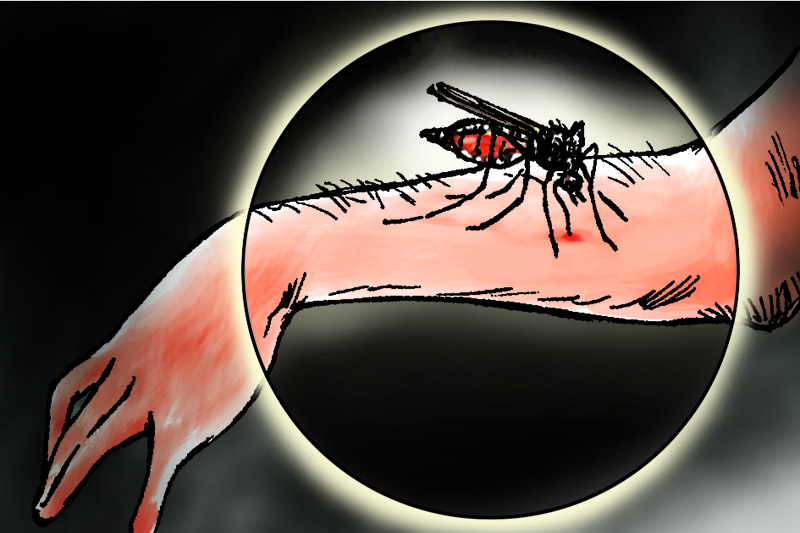Deadly malaria: Matter of concern
Although the government’s published annual report on malaria shows a gradual declining trend and a stable one over the past few years, it is for sure that we categorically cannot rule out the possible risk of imported deadly malaria
Vector-borne diseases increasingly surface in the country. The post-monsoon season is the best breeding time for vectors in Nepal.
Vectors are living organisms that can transmit infectious diseases between humans or from animals to humans, and are usually blood sucking insects, for instance, mosquitoes, ticks, flies, sand flies, fleas etc. kala-azar, elephantiasis, Japanese encephalitis, dengue, chikungunya, scrub typhus and Malaria are well-known vector-borne illnesses in Nepal.
The Sukraraj Tropical and Infectious Disease Hospital has begun to detect malaria in patients with febrile illnesses.
Over the past four weeks, at least seven malaria cases have been detected, who were either treated at the Sukraraj Tropical and Infectious Disease Hospital (two cases) or are being treated in different hospitals in Kathmandu.
Of the total, six tested positive for plasmodium falciparum, and one tested positive for plasmodium vivex. There are five species of plasmodium that cause malaria in humans known as plasmodium falciparum, plasmodium vivex, plasmodium ovale, plasmodium malariae and plasmodium knowlesi.
Plasmodium falciparum is the deadliest and can cause neurological problems called “cerebral malaria” which can lead to death, if not identified and treated promptly. For this reason, nearly half a dozen plasmodium falciparum cases detected from a single hospital in just a single month is a matter of grave concern.
According to the recently published Annual Report (Report 2015/2016), 54 VDCs of the Tarai region of the far-western development region are considered to be high-risk areas for malaria transmission in Nepal.
A total of 162 cases of falciparum malaria were reported during the last fiscal year in Nepal, of these 92 cases were imported. Thus, imported malaria is expected to increase in the future.
Recently, our attention has been drawn towards malaria cases that are being imported not only from neighboring country, India, but also from other regions of the world, especially from Africa, where malaria is estimated to be 90% of the global malaria cases.
The number of Nepalese workers going to African countries for better employment opportunities has steadily risen in recent years.
It is, thus, reasonable to assume that infectious diseases including African malaria are likely to increase over the coming days. It’s not only about the number of malaria cases, but the treatment guidelines that differ between Africa and Asia due to biological characteristics and behavioral traits of malaria.
Symptoms usually develop seven to 30 days after the bite of an infected female anopheles mosquito. High-grade fever with chills and rigors, sweating, headaches, body aches, nausea, vomiting are common symptoms of malaria.
Physical findings include mild jaundice, pallor of the conjunctivae (due to anemia), enlarged liver and spleen size, low blood pressure, low blood glucose, breathing difficulty, kidney diseases, neurological abnormalities such as seizures, abnormal behavior, unconsciousness or even coma, which are signs of severe malaria.
Relapse or repeated attack due to plasmodium vivex and ovale infections after recovery is common after months or even years. It’s interesting to note here that the pattern of fever vary based on the species of malaria.
Fever peaks every 48 hours in plasmodium vivex and ovale infections, and in every 72 hours in plasmodium malaria infection. Fever in plasmodium falciparum occurs every 48 hours, but this pattern lacks uniformity. In plasmodium knowlesi, fever spikes every 24 hours.
Another, so called “Super Malaria”, a mutated strain of falciparum malaria, has recently been identified and is now spreading rapidly in South East Asian countries. The Indian subcontinent countries could be the next targets of Super Malaria due to its close geographic location within the same region.
Super Malaria first emerged in Cambodia and has been found to be artemisinin resistant, the widely used first-line anti-malarial drug to treat falciparum malaria. In some parts of Cambodia, the treatment failure rate was found as high as 60%. Similar scenario cannot be overlooked in this country, as falciparum malaria is being detected year after year in Nepal.
However, so far only a few studies have been focused on genetic analysis of falciparum malaria in Nepal. More studies are needed due to growing malaria carrying mosquito populations in Tarai as well as hilly regions because of rapid urbanization and climate change.
Nepal, thus, needs to be constantly vigilant about this Super Malaria henceforth. The WHO as well as private research institutes can play a vital role in identifying this emerging new Super Malaria in Nepal.
Finally, although the government’s published annual report on malaria shows a gradual declining trend and a stable one over the past few years, it is for sure that we categorically cannot rule out the possible risk of imported deadly malaria such as “Super Malaria” through travelers and or even new malaria strains that may have been evolving locally in Nepal.
Long-term research on malaria and effective surveillance network would be the best option to address these issues.
Pun is Coordinator of the Clinical Research Unit Sukraraj Tropical and Infectious Disease Hospital






